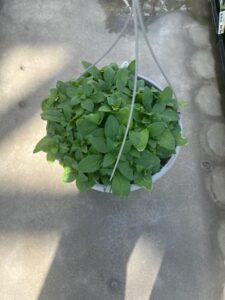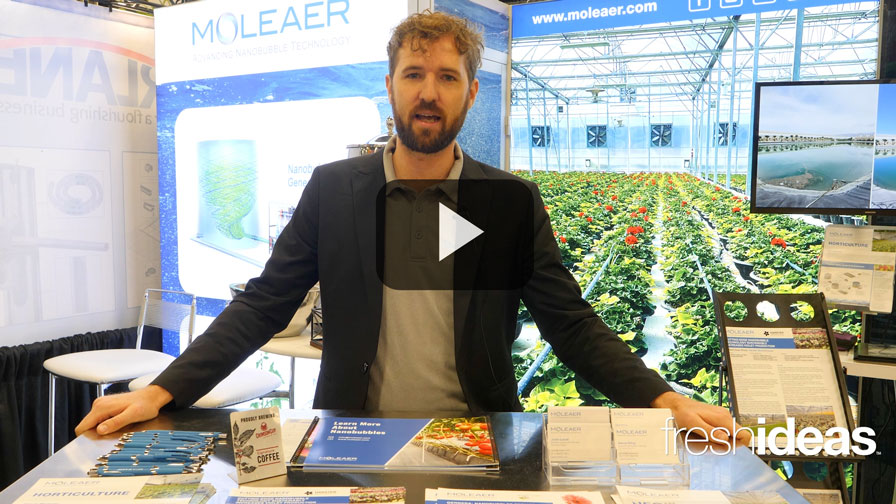How to Keep Your Petunias Actively Growing in a Highly Controlled Way

The most important objectives during Phase 1 of growing your petunias are to build structure and develop a tough root system. Photo: Steve Garvey/Dallas Johnson Greenhouses
The key to keeping petunias actively growing, while at the same time controlling irrigation and fertilizer, is a two-phased approach: growing to size with half-watering and plant growth regulators (PGRs) and forcing flowers. As a large wholesale grower with varying size and finish date requirements, traditional methods of growing cold and utilizing morning dips are ineffective.
Half-Watering Makes a Difference When Done Right
At Dallas Johnson Greenhouses (DJG), our media is a peat moss/wood fiber blend (70/30). Our recipe also includes lime and a wetting agent, preventing it from drying out as quickly as a more conventional media. This combination requires a half-watering approach. Half-watering means watering the newly planted plug and roughly 10% more of the media until wet, but not saturating the entire pot. Our preferred constant feed is 200 ppm, 17-4-17. This allows us to water and feed more frequently (with automation), rather than saturating and forgetting it for a week or more. Giving the plant more constant water and feed pushes it and increases the electrical conductivity (EC) in the mix for future use.
Early PGR Use Helps Build Structured Growth
Another component of the first phase is our use of PGRs. Many growers think of PGRs as an afterthought in producing top-quality plant material. However, at DJG, we see them as a tool of our trade and are proud to use them. We use PGRs early in the growing cycle to build structured growth, rather than simply using them late to stop growth. The use of PGRs in addition to our feeding program builds a toned, well-branched plant, preparing it for phase two. Phase one (feeding and growing) continues until we reach about ¾ grown of the finished container. Regardless of container size, the formula stays the same.
Control Moisture to Induce the Right Amount of Stress
When it’s time for the second phase, the goal is to make the crop flower at the appointed time, taking the plants from a lush green, vegetative state into a flowering, reproductive plant — the kind everyone wants to buy! Our method of forcing flowers results from stressing the plants. If we withhold water and feed, the plant senses something is amiss and sends out a flower.

Phase 2 transitions your petunia crop from a vegetative state to a reproductive stage. Withholding water and feed at this stage initiates controlled stress that triggers flowering in the plants.
Moisture levels are also important in this phase. In phase one, on the 1 to 5 watering scale, we always try to keep the moisture level between 2 and 4 with feed. In phase two, we tend to run from 1 to 3, letting the plants get almost uncomfortably dry, nearly turning gray. It is a fine line, and I’ll admit to taking crops too far while experimenting, but in my experience, this is what works. When we do water at this point, it is with fresh water and just enough to get the moisture level to a 3. All the work in phase one to build structure and a tough root system gives us the freedom to go to this extreme.
Timing Is Everything
Now, it’s a waiting game for a bud to show up. As we walk the crops, we’re scouting for buds, the hints of color that point to success. We are diligent not to stray from the fresh water 1 to 3 cycling until color begins to show. Once we see flower buds cresting and expanding, the hard part is over. The arrival of the expanding flower buds signals the plant is bulletproof, and we can begin feeding again. This increases the EC back, ensuring the flower develops and opens. Some wonder if this will throw the plant back into vegetative mode and cause the plant to stretch. I used to think Bonzi was the best PGR in the world — perhaps I was young and inexperienced. And while I still use and appreciate Bonzi, I know the best PGR is a flower!
Once that flower has arrived and is opening, we can go back to phase one practices. We feed and keep the moisture level 2 to 4, making sure we keep the petunia actively growing and keep stacking flowers, one flush after another. It’s critical at this point, not to hit low moisture levels or you will lose all your flowers. Timing is everything!
Sometimes out-of-the-box thinking moves your business forward. We have found this two-phased approach to do just that at DJG. Note: it’s not right for all crops, but certainly works for petunias. Give it a shot — with the right timing and practice, a flush petunia won’t be in the greenhouse long. It will be right where it belongs — the consumer’s yard.









